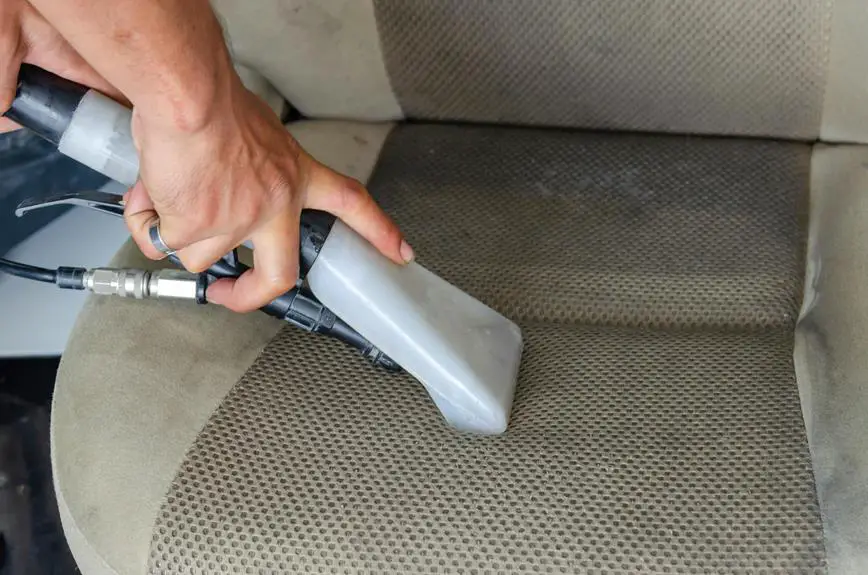When it comes to caring for waxed fabrics, you need to approach maintenance with a clear strategy. You should start by understanding the unique properties of these materials, as improper care can lead to diminished performance. For instance, surface dirt can often be managed with a simple damp cloth, but what do you do when deeper stains appear? And how often should you consider re-waxing? Exploring these questions will ensure your waxed items remain functional and aesthetically pleasing for years to come.
Table of Contents
Key Takeaways
- Gently wipe waxed fabrics with a damp cloth and mild soap; avoid harsh chemicals to protect the wax coating.
- Air dry items away from direct sunlight and humidity to prevent mildew and degradation of the wax.
- Regularly re-wax to restore waterproof qualities and maintain the protective layer of the fabric.
- Store waxed items rolled in breathable bags and ensure they are dry to prevent creases and damage.
Understanding Waxed Fabrics
Waxed fabrics are versatile materials made by applying a protective layer of wax to cotton or linen, enhancing their durability and water resistance. You'll find these fabrics ideal for various applications, including bags, jackets, and outdoor gear. The wax coating not only provides protection against moisture but also gives the fabric a unique, rugged look that many people appreciate.
When you choose waxed fabrics, you're opting for a product that combines functionality with style. The wax can withstand wear and tear, making it perfect for daily use. However, it's essential to understand that this material requires specific care to maintain its properties. The wax layer can break down over time, especially with frequent exposure to harsh conditions or improper cleaning methods.
You should also be aware of the breathability of waxed fabrics. While they repel water, they can trap moisture inside if not cared for properly. When considering your options, think about how you'll use the fabric, as this will impact its longevity and performance.
Ultimately, understanding the characteristics of waxed fabrics will help you make informed decisions for your projects and daily wear.
Cleaning Techniques
To keep your waxed fabrics looking their best, it's important to use the right cleaning techniques. Start by gently wiping the surface with a damp cloth to remove any dirt or dust. Avoid using harsh chemicals or abrasive cleaners, as they can damage the wax finish. Instead, opt for mild soap mixed with water. Dampen your cloth in this solution and lightly scrub any stained areas.
If you encounter tougher stains, a soft sponge can help lift them without compromising the fabric. Always test any cleaning solution on a small, inconspicuous area first to ensure it won't cause discoloration. After cleaning, rinse the cloth and wipe off any soap residue with a clean, damp cloth.
For regular maintenance, consider spot cleaning rather than full washes. This approach not only preserves the wax coating but also extends the life of your fabric. If your fabric gets wet, gently pat it dry with a towel, avoiding excessive rubbing.
Drying Procedures
After cleaning your waxed fabrics, it's essential to dry them properly to maintain their protective coating. Proper drying prevents moisture from getting trapped, which can lead to mildew or degradation of the wax.
Here are three effective drying methods you should consider:
- Air Drying: Hang your waxed fabric in a well-ventilated area, out of direct sunlight. This method allows for gentle drying without risking damage to the coating.
- Towel Drying: For quicker results, lay your waxed fabric flat on a clean, dry towel. Gently roll the towel with the fabric inside to absorb excess moisture, then allow it to air dry completely.
- Low Heat Drying: If you're in a hurry, you can use a hairdryer on a low-heat setting. Keep it at a safe distance, moving it around to avoid overheating any one spot.
Whichever method you choose, remember to avoid machine drying or direct heat sources like radiators, as they can strip away the wax and ruin your fabric.
Taking these precautions will help prolong the life of your waxed fabrics, ensuring they remain functional and stylish.
Re-Waxing Your Fabrics
Re-waxing your fabrics is crucial for restoring their protective layer and ensuring they continue to repel water and resist wear. Over time, your waxed items can lose their waterproof qualities due to exposure to the elements, so it's important to reapply wax regularly.
To start the re-waxing process, make sure your fabric is clean and dry. Gently brush off any dirt or debris, and if necessary, wash it with a mild soap and let it dry completely.
Next, choose a high-quality wax suitable for your fabric type. You can use a wax paste or a spray-on wax for convenience.
Apply the wax evenly using a cloth or sponge, working it into the fabric in small sections. Be sure to cover all areas, focusing on seams and high-wear spots.
After you've applied the wax, use a heat source, like a hairdryer, to help it penetrate the fabric better. This step ensures an even finish.
Storing Waxed Items
Proper storage of your waxed items is key to maintaining their durability and waterproof qualities. By following a few simple guidelines, you can ensure your items remain in top condition for years to come.
Here are three essential tips for storing your waxed fabrics:
- Keep them dry: Moisture can damage the wax coating. Store your items in a cool, dry place away from direct sunlight or excessive humidity.
- Avoid folding: Instead of folding, roll your waxed fabrics to prevent creases and cracks in the wax. This method helps maintain the integrity of the material.
- Use breathable bags: If you need to cover your items, opt for cotton or linen bags instead of plastic. This allows air circulation and prevents the buildup of moisture.
Troubleshooting Common Issues
When you encounter issues with your waxed fabrics, it's essential to know how to tackle them effectively.
You might face challenges like stubborn stains, surface damage, or fabric discoloration.
Let's explore some practical solutions to keep your items looking their best.
Removing Stains Effectively
Stains on waxed fabrics can be tricky, but with the right approach, you can tackle them effectively. To help you get started, here are three essential steps to follow:
- Act Quickly: The sooner you address a stain, the better your chances of removing it successfully. Blot the stain gently with a clean cloth to absorb excess liquid, but don't rub, as this can spread the stain.
- Use the Right Cleaner: Choose a mild soap or detergent mixed with warm water. Avoid harsh chemicals that could damage the wax finish. Dampen a cloth with your solution and gently dab the stained area. Rinse the cloth and repeat until the stain fades.
- Re-Wax If Necessary: After cleaning, the wax finish may look dull. If you notice this, reapply a thin layer of wax to restore its protective barrier and sheen.
Repairing Waxed Surface Damage
Repairing damage on waxed surfaces requires a careful approach to restore their original luster and functionality. If you notice scuffs, scratches, or areas where the wax has worn off, don't worry; you can fix it.
Start by cleaning the affected area with a soft, damp cloth to remove dirt and debris. Allow it to dry completely.
Next, apply a thin layer of wax to the damaged spot. You can use a specialized fabric wax or a beeswax-based product. Use your fingers or a clean cloth to work the wax into the fabric, ensuring even coverage. Pay attention to the edges to blend it seamlessly with the surrounding area.
Once you've applied the wax, let it sit for a few minutes to allow it to bond with the fabric. Finally, buff the area gently with a clean, dry cloth to restore shine.
If the damage is extensive, you may need to repeat the process or consider re-waxing the entire fabric for uniformity. Regular maintenance helps prevent further damage and keeps your waxed surfaces looking their best.
Preventing Fabric Discoloration
To keep your waxed fabrics looking vibrant, it's essential to understand the common causes of discoloration and how to prevent them. Here are three key factors to watch out for:
- Direct Sunlight: Prolonged exposure to sunlight can fade the color of your fabric. Try to store or use your items in shaded areas whenever possible.
- Moisture and Humidity: Excessive moisture can lead to mold or mildew, resulting in unsightly stains. Keep your waxed fabrics dry and store them in a cool, dry place.
- Harsh Chemicals: Cleaning agents or solvents can strip the wax coating, leading to discoloration. Always opt for gentle cleaning methods, like a damp cloth, and avoid using bleach or abrasive cleaners.
Frequently Asked Questions
Can I Use Fabric Softener on Waxed Fabrics?
You shouldn't use fabric softener on waxed fabrics. It can break down the wax coating, reducing its effectiveness. Instead, opt for gentle cleaning methods to maintain the fabric's integrity and prolong its lifespan.
Are Waxed Fabrics Waterproof?
Waxed fabrics aren't completely waterproof, but they're water-resistant. They repel water to a certain extent, keeping your belongings dry during light rain. However, prolonged exposure can lead to moisture seeping through, so be cautious.
How Long Do Waxed Fabrics Last?
Waxed fabrics can last several years with proper care, typically ranging from 2 to 5 years. Factors like usage frequency, exposure to elements, and maintenance directly affect their longevity, so be mindful of how you treat them.
Can I Iron Waxed Fabrics?
You shouldn't iron waxed fabrics directly. The heat can melt the wax, ruining the finish. Instead, use a low heat setting with a cloth barrier, or steam them carefully to avoid damaging the surface.
What Materials Can Be Waxed at Home?
You can wax various materials at home, like cotton, canvas, and denim. Just ensure they're clean and prepped properly. Natural fabrics work best, as synthetic ones may not absorb the wax effectively. Happy crafting!
- The Scalability Challenges of Novel Sustainable Materials - June 7, 2025
- Are Lab-Grown Cottons or Leathers a Sustainable Future? - June 7, 2025
- What Is Naia™ Cellulosic Fiber and Is It Eco-Friendly? - June 7, 2025




